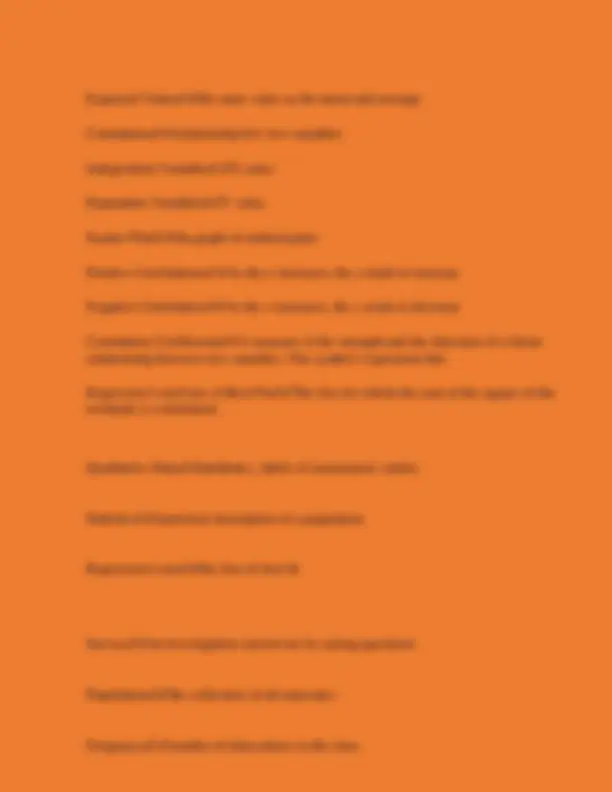





Study with the several resources on Docsity

Earn points by helping other students or get them with a premium plan


Prepare for your exams
Study with the several resources on Docsity

Earn points to download
Earn points by helping other students or get them with a premium plan
Community
Ask the community for help and clear up your study doubts
Discover the best universities in your country according to Docsity users
Free resources
Download our free guides on studying techniques, anxiety management strategies, and thesis advice from Docsity tutors
A concise overview of fundamental concepts in probability and statistics. It defines key terms such as probability, sample space, events, and random variables. The document also introduces basic probability rules, including the multiplication rule, addition rule, and the law of large numbers. It further explores concepts like permutations, combinations, and correlation, providing a foundational understanding of these statistical principles.
Typology: Exercises
1 / 5

This page cannot be seen from the preview
Don't miss anything!




Probability/ Statistics Probability✔✔the likelihood that an event will occur Probability experiment✔✔an action, or trial, through which specific results (counts, measurements, or responses) are obtained Outcome✔✔the result of a single trail in a probability experiment Sample space✔✔the set of all possible outcomes of a probability experiment Event✔✔a subset of the sample space. It may consist of one or more outcomes. Simple event✔✔an event that consists of a single outcome fundamental counting principle✔✔if one event can occur in "m" ways and a second event can occur in "n" ways the number of ways the two events can occur in sequence is m x n Classical probability✔✔used when each outcome in a sample space is equally likely to occur Empirical probability✔✔based on observations obtained from probability experiment Subjective probability✔✔Result from intuition, education guesses, and estimates Law of Large Numbers✔✔as an experiment is repeated over and over, the empirical probability of an event approaches the theoretical (actual) probability of an event Range of probabilities✔✔probability of an event E is between 0 and 1 inclusive 0<P(x)< Complement of an Event✔✔the set of all outcomes in a sample space that are not included in event E. P(E') Conditional Probability✔✔probability of an event occurring, given that another event has already occurred. P(B/A)
Independent Events✔✔The occurrence of one of the events does not affect the probability of the occurrence of the other event Dependent Events✔✔one event affects the probability of the other event occurring The Multiplication Rule✔✔The probability that two events A and B will occur in sequence is: P (A and B)= P(A) x P(B/A). If independent: P (A and B)= P(A) x P(B) Mutually Exclusive Events✔✔Two events are mutually exclusive if they can't occur at the same time The Addition Rule✔✔The probability that events A or B will occur, P (A or B) is given by: P (A or B)= P (A) + P (B)- P(A and B), Mutually Exclusive: P (A or B)= P (A) + P(B) Factorial✔✔N! Permutation✔✔An ordered arrangement of objects. Permutation✔✔nPr=n!/(n-r)! where r < n Distinguishable Permutations✔✔N!/n1!x n2! x n3!...nk! Where n1+n2+n3+....nk+n Combinations✔✔is a selection of r objects from a group of n objects without regard to order and is denoted by nCr. Combinations✔✔nCr= n!/r!(n-r)! Random variable✔✔represents a numerical value associated with each outcome of a probability experiment Discrete✔✔It has a finite or countable number of possible outcomes that can be listed Continuous✔✔It has an uncountable number of possible outcomes represented by an interval on the number line Probability Distribution✔✔Lists each possible value the random variable can assume, together with its probability. It must satisfy the following conditions: 0<P(X)< EP (X)= 1
Statistics✔✔the science of collecting, organizing, analyzing, and interpreting data Pareto Chart✔✔histogram with decreasing bars The point a regression line passes through✔✔_ _ (x,y ) Interquartile range✔✔difference between the first and third quartile Range✔✔the distance between the max and min Mean✔✔sum of data entries divided by number of entries Mode✔✔piece of data that occurs the most Quantitative✔✔numerical measurements or counts Residual✔✔the difference between the observe y-value and the predicted y-value Simple Event✔✔single outcomes Sample Space✔✔set of all possible outcomes Subjective Probablity✔✔what you think will happen
Classical Probability✔✔when each outcomes is equally likely to occur Combination✔✔selection of objects without order Permutation✔✔"ordered" arrangements of objects Empirical Probablity✔✔probability determined by experiment Outcome✔✔the result of a single trial Mutually Exclusive✔✔two events that cannot occur at the same time Complement of an Event✔✔all outcomes that are not desired Event✔✔one or more outcomes Dependent Events✔✔two events that rely on each other Outliers✔✔are extreme values not in the norm